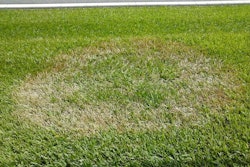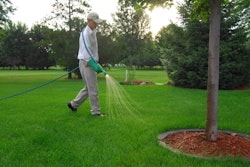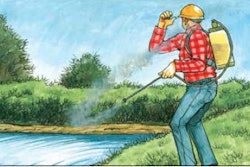Whether you are developing a fertility program for a new customer or analyzing what you currently offer an existing client, your first step should be to send a soil sample in for testing. In return, you will get a report that will identify deficiencies in the soil. It covers a variety of elements, including soil pH, CEC (cation exchange capacity) and the amounts of phosphorus, potassium and secondary nutrients (magnesium, calcium and sulfur). Nitrogen is not usually a nutrient represented in the report because it’s too difficult to pinpoint with accuracy, given its mobility within soil. But it is obviously a very important part of fertilization because it’s vital for the production of chlorophyll, which gives turf its rich, green color.
Once you have your report, you’ll be able to select a fertilizer that will meet the needs of turf. You’ll see what soil nutrients are needed and which ones are too abundant and need to be reduced.
The type of soil you have will also dictate fertilizer requirements. If you have a sandy soil that doesn’t retain water, you’ll need more nitrogen fertilizer than if you have a clay-type soil that tends to hold onto water – and nutrients. If your soil is particularly sandy, you should consider adding some organic amendments to make it less so. You should also consider a slow-release fertilizer that will help alleviate leaching and also cut down on your number of applications. Application amount
How many times a year you apply fertilizer to turf is as important as how much you apply. Some turfs require as many as five applications per year while others need only three. Each additional application you’re willing to make cuts down on the rate of fertilizer you need to use to achieve desired results, thus lessoning your chances of burning turf foliage. However, if you can make only those two applications I mentioned earlier, and you’re forced to use a higher rate of nitrogen, select a slow-release variety. Doing so will also lessen your chance for burning turf. If, on the other hand, you can make several applications per year, you can select a quick-release fertilizer that will provide a more consistent green turf throughout the growing season.
Turf type & timing
Different species of turf have different nitrogen fertilizer requirements, so it’s important to identify the turf species you’re working with. For example, the rate of application is going to differ between Kentucky bluegrass, which likes 3 to 4 pounds of nitrogen per 1,000 square feet per year, than for fine fescue, which likes only 1 to 2 pounds of nitrogen per 1,000 square feet per year. If you’re working with a mix of several species on one property, you should decide which species is preferred by the client and develop a fertility program around that one.
The application requirements for cool-season turfgrasses are different than those for warm-season turfgrasses. If you are managing cool-season grasses and can make three applications of fertilizer, aim for mid spring (May), late summer (August) and late fall (November). If you can add a fourth application, early spring (March) should be your target. Know that the late summer application is very likely the most important one because it helps turf heal from drought and heat injury.
For warm-season turfgrass lawns, you should make fertilizer applications in late spring (May), late summer/early fall (late August/early September), and late fall (November).










